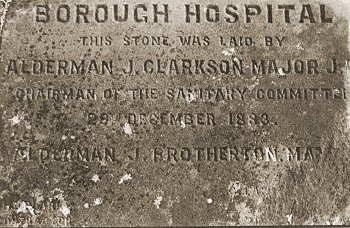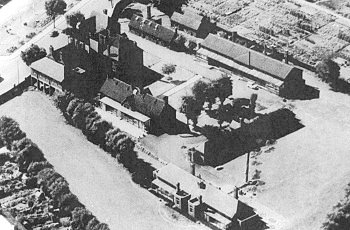|

|
Of the folklore associated with the 5
Victorian hospitals developed in Wolverhampton, namely The
General (opened in 1849, later The Royal), the Eye Infirmary
(opened in 1881), the Isolation Hospital (opened in 1884), the
Surgical Dispensary for Women (opened in 1886), the Queen
Victoria Nursing Institute (opened in 1895) and the Women’s and
Children’s Convalescent Home (opened in 1873); none have created
more parental concern than for a child to be taken to the
Isolation Hospital that treated ‘fevers’.
The incidence of these diseases had been of
enormous proportions throughout the Victorian period, initially
both cholera and smallpox had caused high death rates in both
Wolverhampton and Bilston. With the resultant improvements in
both water supply and sewage disposal, cholera had considerably
dissipated by the early 1880s but increases with the zymotic
diseases was markedly evident.
|
|

The foundation stone. Courtesy of Neil Fox.
|
Dr. Henry Malet, the then Medical Officer of Health and Honorary
Consultant Physician at the General Hospital, pressed the local
authority to provide a facility for the isolation and treatment of
patients with such conditions. Duty was done and the first such
hospital facility built and supported by Wolverhampton Borough
Council was enacted in 1883 with the laying of the foundation stone.
The hospital opened its doors on the Holly Hall estate in Pond Lane
on the then edge of town on the 6th February 1884.
|
| The immediate admission of some 35 patients with
smallpox, of whom 4 died was conclusive evidence of the hospital’s
necessity. Additionally it was recorded that in the third quarter of
1884, 106 deaths from Infantile Diarrhoea occurred with the
resultant concerns. With some improved pick up in vaccination by
1885, smallpox had receded only to be overtaken by the next cyclical
disease of Scarlatina (Scarlet Fever). |
| During this year some 264 patients were admitted of
whom 40 died, some 15% compared with a death rate in the previous
decade of 57%. By 1892 the hospital facilities had been considerably
enhanced with two pavilions, which with the wooden annexe of two
wards, plus administrative buildings, nurses accommodation and
laundry, plus disinfecting facilities offered good local care. |

An aerial view of the hospital. Courtesy of
Neil Fox. |
|
In 1894 a recurrence of Smallpox flared with 67
new cases, in addition Diphtheria, Measles and Typhoid continued to
present pressing problems. It is interesting to read in the History
of St. Stephen’s School, Springfields that complete closure of the
school was necessary due to the numbers of children with measles.
The number of related deaths from Tuberculosis in Wolverhampton
peaked at this period to 150, but fell back at the turn of the
century to the low 100s.
Throughout this period electric light was
installed and a further isolation hospital was opened at Moxley in
1923. The Schick test was introduced resulting in immunisation for
all children in 1928 but the beneficial uptake and reduction in the
disease was not evident until the 1940s.
|
|

Another view of the hospital. Courtesy of Neil
Fox.
|
In 1928 a further cubicled ward of ten beds was opened and after
patient numbers increased the hospital a training school for the
Infected Diseases Nursing Certificate by the GNC. Whilst the war
years saw a marked reduction in the incidence of most infectious
diseases, both poliomyelitis and tuberculosis continued to cause
concern, the later condition requiring many weeks of treatment and
bed rest. The available 66 beds at Parkfields were insufficient and
many local patients were sent to Prestwood, Kinver and elsewhere.
|
| For those patients treated at Pond Lane, daily
papers, library books and snooker and darts facilities improved the
lot of the in-house sick as did the Christmas visit by the local
pantomime cast. |
|

The cubicled ward of 10 beds that was opened
in 1928. Courtesy of Neil Fox.
|
|
The redoubtable figure of Matron Knox
Thomas and her group of senior sisters, most of whom spent the whole
of their working lives at the hospital reigned supreme. With the
introduction of the NHS in 1948 an infectious diseases block was
opened at New Cross, which had laboratory facilities and residential
doctors and a Chest Department. The ward and appropriate facilities
were thus seen as reducing the Parkfields operations. Added to these
factors the widespread immunisation polices adopted by Health
Authorities to curtail the Zymotic disease meant that the day of the
fever hospital was drawing to a close.
A reprieve against closure in 1976 lasted for
two years and a plan to create a day centre for mentally handicapped
patients came to nothing and finally in 1984 the hospital closed
thus ending 100 years of service to the community. The grounds of
Parkfields Hospital now compose a housing development. It is
interesting to note that as we entered the 21st century
the evidence of H.I.V., Hepatitis and Tuberculosis have become
dangerous realities.
In 1950 a single case of Smallpox recurred in
Bilston and a similar scare arose in Wolverhampton, but medical
controls were adequate and both cases came to nothing. Parkfields
was also known as ‘The Borough Hospital’ throughout its life.
Roy Stallard
T.D.
|
 |
Return to
the
health section |
|